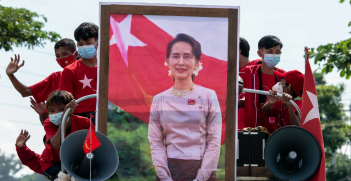Reality or Rhetoric: Understanding Gender Inequality and Education in Myanmar

Women outnumber men at every level of education in Myanmar. Yet even with high levels of educational attainment, women in Myanmar remain economically repressed and politically underrepresented.
Gender equality in Myanmar entails a complex balance between cultural and historical norms and contemporary outcomes. Traditional conceptions of gender roles are embedded in Burmese culture, internalised and often unquestioned. Since opening its borders in 2010, Myanmar’s high levels of gender inequality have begun to be recognised. Statistics indicate that both men and women have equal access to education. However, women have lower labour force participation, leading to weakened long term political and economic empowerment. Why is education, often touted as best practice for increasing gender equality, failing the women of Myanmar?
History
Prior to colonisation, Myanmar’s education system was administered through a predominantly male monastic education system. Female education was considered unimportant or, at best, secondary. From 1868, the colonial administration introduced a secular, coeducational schooling system. Between 1910 and 1930, female representation in schools grew dramatically. By the mid-20th century, Myanmar was regarded as having one of the best education systems in South East Asia.
The imposition of military rule in 1962 saw the educational quality plummet. Schools were starved of resources and curriculum reforms replaced critical thinking with rote, military-controlled learning. Girls’ participation in education was restricted until it became close to non-existent. In the following decades, prolonged internal conflict, isolation, lack of funding, and use of education as a tool of social control caused the education system to stagnate. While the region developed, Myanmar was left behind.
In 2008, the establishment of the new Constitution emphasised education as a priority for reform, and a primary responsibility for the incoming government. Article 28 of the 2008 Constitution stipulates the union shall “strive to improve education” and “implement a modern education system.” Accordingly, between 2008 and 2013, education reform policies skyrocketed, and the number of girls in education climbed dramatically. Since the new constitution’s implementation, Myanmar’s education expenditure has more than doubled, and now represents 7.75 percent of the total budget.
However, despite these statistics, the role of women in modern Burmese society remains restricted. Women in Myanmar remain economically disempowered, underpaid, and underrepresented in the workforce and at every level of government. The labour force participation rate for men is 83 percent, and only 55 percent for women. Only 31.5 percent of senior and middle management positions and 10.2 percent of parliamentary seats are held by women. Unsurprisingly, Myanmar’s Gender Inequality Index ranking remains 148th of 189 countries.
Finding the Origins
Our research found factors which help explain this paradox. Our team conducted qualitative research in the Nyaungshwe Township of Taunggyi District in Shan State. We found two major factors perpetuating gender inequality despite women’s access to education. Firstly, the poor quality of the education system works to actively disempower female students. Secondly, social attitudes towards education and gender perpetuate traditional roles.
Traditional attitudes toward gender roles are promoted as soon as children start school. The curriculum itself is implicitly gendered. For example, an English workbook for kindergarten students depicted female illustrations alongside verbs like “cook,” “clean,” “eat.” Traditionally male activities, including farming and sport, were depicted with images of men. From a young age, children are associating these actions and concepts with a particular gender. Exposure to this (perhaps seemingly insignificant) stereotyping at such a young age provides the basis for children’s world view. Interviewees from the Gender and Development Institute and Norweigan Refugee Centre both reported that this gender stereotyping was commonplace in the curriculum across age groups.
This implicit promotion of gender roles is more explicitly supported by teachers’ attitudes. Interviews with staff members at schools revealed a focus on encouraging girls to pursue traditionally female-dominant industries such as teaching. In contrast, the teachers felt boys would be more suited to politics or management. Promotion of these ideas throughout the education system leads to the social conditioning of women that pushes them to pursue low-income careers.
Furthermore, the content learned in education does not contribute to the development of workplace-relevant skills. All respondents reported that, even at a tertiary level, the skills gained in education were rarely used in the workforce. Only two respondents worked in the occupations they studied at university, both teachers. Respondents typically spoke of their time in tertiary education disparagingly, their expectation of future reward for their hard work unfulfilled. For most low- to middle-income families, occupations such as farming yielded the greatest returns. One parent stated she had a degree in history from a local university but returned to farming for a higher income.
Paradoxically, in Myanmar, jobs which require higher education attract little prestige and are poorly paid. These trends stem from a historical legacy wherein professions such as law and finance were part of largely irrelevant institutions. With the rule of law controlled by an authoritarian power and corruption rife in finance and administration, these roles were somewhat redundant. This has created professional divides which still remain today. Careers which do not require university education, including politics and farming, attract higher pay and are typically male dominated. Women are staying in school longer, often gaining a tertiary education. However, this causes them to end up in professions such as law and teaching which require university degrees, but are paid less.
This phenomenon has a dual effect. Firstly, it means the long-held belief that education results in long term economic empowerment, in this context, is false. More insidiously, it means that the longer girls remain “stuck” in school, the less they are earning compared to their male counterparts. A high proportion of boys, typically in rural areas, drop out at the end of primary school to enter the workforce, often in a trade or on their family’s farm. This creates an impossible-to-close economic gap between the sexes before they even reach adulthood.
Closing the Gap
Education as a tool for empowerment works only if that education is informed, effective, and respected. For Myanmar, traditional policy approaches focussing on achieving gender equity through girls’ access to education are simply not working. Burmese women spend years in school, yet this limits their long-term empowerment, instead of supporting it.
However, there are some positives. High participation in education can be a platform to encourage gender balanced social attitudes in younger generations. This social shift is already starting through afterschool youth groups and new women’s organisations. These organisations, which allow communities to share concerns and experiences, should be encouraged through increased government support and consultation processes.
A push for change must come from national and local levels, meeting in the middle to drive progress. At a grassroots level, the communication of new ideas must come from the teachers who are currently perpetuating old, sexist stereotypes. This could occur through diversity and inclusion awareness training for teachers, designed specifically to help them identify and counteract bias. Nationally, the government should push to raise the status of traditionally female careers, especially teaching. Doing so requires economic investment and increased resources, but this will empower Myanmar’s teachers and, in turn, its students. Increasing teachers’ salaries could boost the status of women in Myanmar and even encourage increased male participation in teaching – working to break down gender barriers one teacher at a time. Finally, the government must work to increase the teaching of applicable skills in higher education, supporting the prestige and financial value of tertiary qualifications. This can be done through financial support for vocational and skills-based degrees, apprenticeships, and training.
Myanmar’s complex history presents a challenge to the accepted norms of development and gender equality. High inequality persists despite high levels of educational participation for women. Solving this paradox requires solutions appropriate to a unique socio-cultural context. To ensure education is a tool for empowering women, the quality of this education must be drastically reformed. These reforms must be supported by diversity and inclusion training for teachers, salary increases in careers which require tertiary education, and increased access to vocational training. Gender equality can best be improved through the use of existing frameworks in innovative ways that are sensitive to the nuances Myanmar’s unique socio-cultural context.
Rebecca Crisp is a third year Bachelor of Laws/Bachelor of Politics, Philosophy and Economics student at the Australian National University. She is ACT State Coordinator at ActionAid Australia and former editor of the Australian Outlook.
Asha Clementi is a third year Bachelor of International Security Studies/Masters of Diplomacy student at the Australian National University. She is the co-founder of The Girls Leadership Network and creator of the Girls Run the World Program.
The authors completed their research as part of an undergraduate study tour, “The Political Economy of Myanmar,” with the ANU in 2019.
This article is published under a Creative Commons License and may be republished with attribution.





